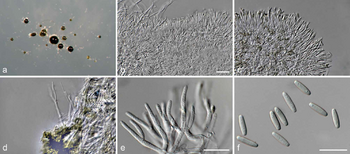Paramyrothecium (genus)
From Pestinfo-Wiki
| Literature database |
|---|
| 48 articles sorted by: |
| • year (recent ones first) |
| • research topics |
| • countries/regions |
| • host plants |

Paramyrothecium roridum (click to enlarge): a) sporodochial conidiomata, b–c) sporodochia, d) setae, e) conidiogenous cells, f) conidia — Scale bars: b = 20 μm (apply to c–d); e–f = 10 μm.
Author(s): L. Lombard, J. Houbraken, C. Decock, R.A. Samson, M. Meijer, M. Réblová, J.Z. Groenewald and P.W. Crous
Source: Persoonia, 2016, vol. 36 p. 210
Author(s): L. Lombard, J. Houbraken, C. Decock, R.A. Samson, M. Meijer, M. Réblová, J.Z. Groenewald and P.W. Crous
Source: Persoonia, 2016, vol. 36 p. 210
Paramyrothecium L. Lombard & Crous 2016
This genus of fungi is closely related to the genus Myrothecium. It has been separated from that genus based on molecular studies as well as the 1–3-septate, thin-walled setae surrounding the sporodochia. The genus include several plant pathogens, the most important being Paramyrothecium roridum which causes leaf spot diseases on a large variety of plants.
Type species: Paramyrothecium roridum
The following species are currently entered in the system: